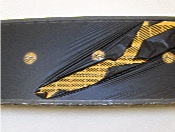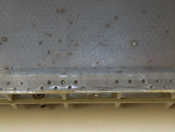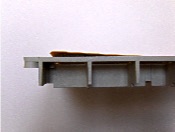Electrostatic Elements
Structure

Manufacture
Quad uses a unique process to tensioning and setting the Mylar diaphragm. Correct execution of the process is critical for proper operation of the element/speaker. Ross Walker gave the following brief description of the Quad process in an interview to HI-FI Review in 1989:
"We stretch it up to the required tension and stick it in the oven. In its cold form, if you stretch it, it will creep. But by putting it in the oven under tension all the molecules will line up to the most stable position so the tension won't change. This is quite important because otherwise the resonance of the speaker would change and it is carefully designed to a particular value. If it was too slack it would hit the plates, too tight the resonance would be too high. Secret ingredient X is used as a damping layer on the Mylar and then we bond the frame to the electrode structure.
So you stretch it, stabilize it then bond it to one side of the electrodes. It is a push pull device with two stators and one moving diaphragm in between."
Failure
The primary cause of element failure over time is loss of glue adhesion. The glue that attaches the stator assembly plate and lattice structure fails and delamination occurs. Glue can also fail that attaches the Mylar diaphragm to the stator.
Element failures can occur from excessive panel leakage. Heavy charring and pitting occurs to the diaphragm. Speakers used in high humidity environments and left constantly energized suffer the greatest leakage damage.
Diaphragms may also fail due to rips caused by element arcing or ageing and fatigue of the Mylar.



Rebuild
Our rebuild process returns the element to original factory specification. We have produced tooling, techniques and materials identical to original Quad manufacturing tooling and processes. Extensive development time, over 500 prototype elements and countless hours of carefully listening have been invested in duplicating the Quad manufacturing process.
Element assemblies are disassembled and cleaned of all glue and other contaminants. Elements are reassembled using a high voltage adhesive to assure long-term adhesion and stability. Proper selection of adhesive is critical for optimum element performance. Adhesive is allowed to cure for 24 hours before inspection and hi-pot testing.
A 3.5 micron Mylar film is tensioned and heat set using the same process developed by Quad. Other approaches to film tension do not result in the long-term stability essential for proper operation of the element. The Quad approach is the reason one will find Quad speakers that are 30-40 years old with proper tension on the diaphragm.
A conductive coating is applied to the tensioned Mylar and the stator elements are reassembled and tested. Elements are subjected to a 72 hour burn-in before final testing and inspection. Each element is evaluated in a reference test speaker to assure proper sensitivity and frequency response performance. The result is a rebuilt element that is an exact electrical and acoustic match to original factory elements.